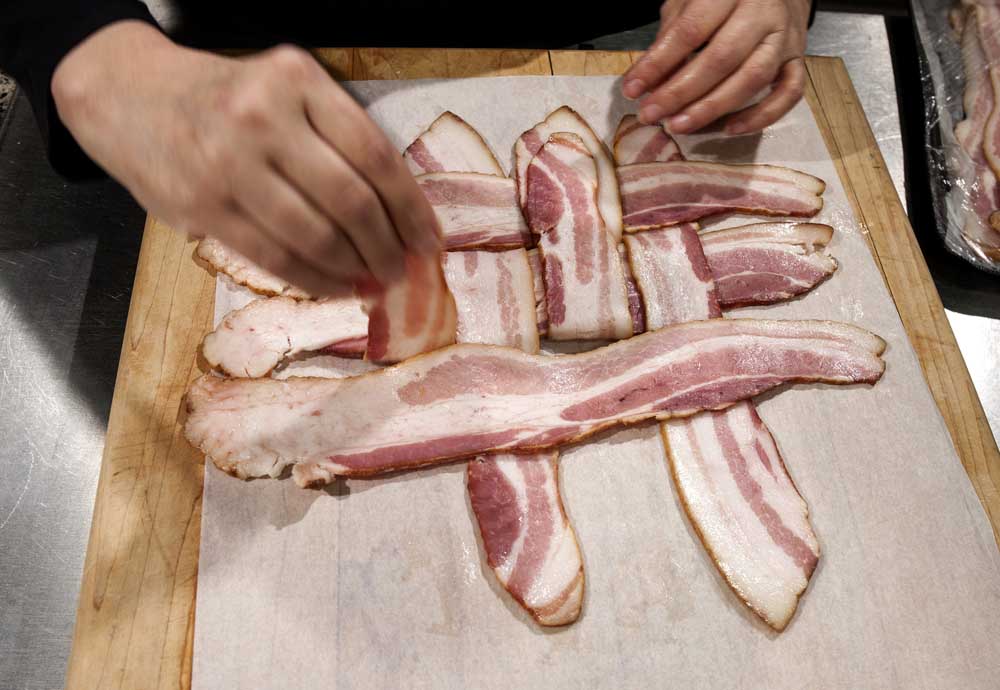Makin’ bacon even better
Published 12:00 am Tuesday, February 10, 2015

- TNSWeave the bacon strips like a basket, pulling up alternate pieces, then tucking in more pieces crosswise.
Bacon was invented long before the age of electricity as a means of preventing meat from spoiling. Now, however, in this modern age of canning, refrigeration and cryogenics, we don’t need to make bacon anymore.
And yet we do.
Why?
Because we love it.
I was a bit confused, truthfully, at first, about what would make a good midwinter story, and therefore enlisted the advice of my editor as to which one to choose from the many ideas we’d kicked around. Without a moment’s hesitation, he said, “I like the bacon idea … because, well, bacon!”
And that pretty much sums up why you need to learn this.
Three products in one!
What is it about bacon that so inflames our passions? Of course there’s that terrific smoky, porky flavor. Perhaps more important, though, it satisfies two of our most basic taste cravings: salt and umami. Suffice it to say these two tastes are related to chemical compounds our bodies crave. Bacon fills that salt craving because it’s made by curing pork belly in salt. Lots and lots of salt. Because one of the functions of salt is to draw out moisture, and because water has no taste, the umami gets increased as well.
Unfortunately the sad truth is most of us don’t get the most out of our bacon. We just cook it and eat it, never realizing every package of bacon gives us not one but three awfully useful and terribly delicious products. Let me explain.
Obviously, there’s the bacon itself. Cook it in strips to your desired doneness and have it with eggs or on a BLT sandwich. (Add a couple of slices of avocado for a “BLAT.” Or, strips of orange rind for a BLORT? OK, I made that one up.)
Alternately, slice it raw crosswise into inch-long, quarter-inch-wide strips called “lardons.” Crisp them in a pan and they’re perfect sprinkled over nearly anything: salads, soups, baked potatoes, vanilla ice cream, chocolate pudding.
O, Bacon, is there anything you can’t improve?
(By the way, lardons cook more evenly than bacon strips and therefore look better than crumbled bacon, which often has large pieces of undercooked bacon fat attached to overly crisp meat portions.)
Here’s the thing, though: If all you’re doing is eating the cooked bacon, you’re consuming less than half of its original, raw weight. The rest is being wasted.
And we can’t have that.
So, what is that unused portion? First there’s the melted (aka “rendered”) fat. After your bacon is cooked, pour the fat through a fine mesh strainer into a lidded glass jar and keep it in the refrigerator. It has all the same porky, smoky flavor as the bacon itself. Use it to saute vegetables or sear meats for an added element of smoky umami.
Crispy bits
And then there are all those little brown, crispy bits that stick to the bottom of the pan as the bacon cooks, like dehydrated clumps of smoky bacon juice. They can add a pile of flavor to soups, sauces, braises and stews. Here’s how:
After pouring the fat into your glass jar, deglaze the pan with broth or white wine or even water. Scrape that deglazed liquid into the jar with the fat. The liquid will sink to the bottom and, when it cools, turn into a super flavorful, gelatinized goo protected from any microorganisms by an airtight seal of solid bacon fat. Next time you’re making a pan sauce or a simple tomato sauce, use the fat to saute your aromatics, then scrape in that gelatinized goo. Trust me, it’s worth the small effort. And the best part is, because of that airtight seal, it’ll last in your fridge for — well, not forever, surely, but it might just still be good when they reanimate your cryogenically frozen head.
A few more ideas
Barding: This simply means covering with fat. The most common iteration of this is meatloaf covered with bacon strips. For larger roasts, such as a boneless turkey breast, weave the strips into a blanket (see sidebar).
Bacon jam: Crisp 1 pound of bacon lardons; remove them from the pan. Saute 1 each minced shallot and onion in the fat, then add a couple of ounces each of brown sugar, maple syrup, cider vinegar, bourbon (if you like) and brewed coffee. Add the bacon back, reduce to a syrupy, jammy consistency, then pulse it in a food processor and serve with crackers, cheese, bread, omelets or freshly cooked vegetables.
Bacon dressing: Like an unreduced bacon jam, just crisp some lardons, add some sliced red onion, vinegar and a little maple syrup and pour over fresh greens — spinach is traditional.






